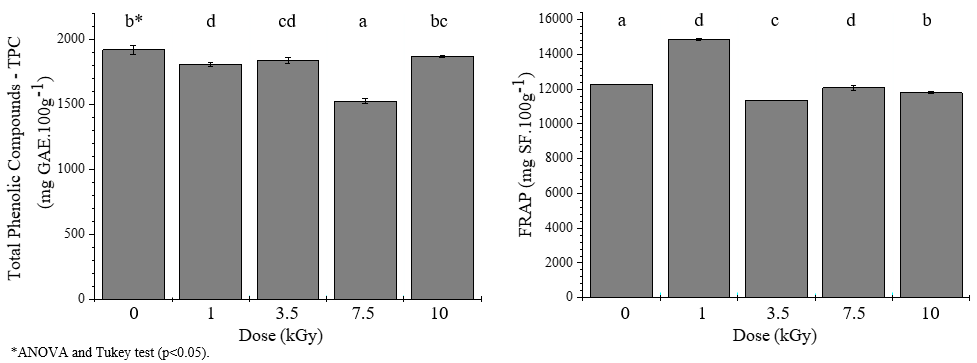Influence of ionizing radiation on bioactive compounds in agro-industrial residues of pitaya peel (hylocereus costaricensis)
Luz M. Rondan-Flores1, João Pedro A. A. Barros1, Bianca G. Negrão1, Daili Barreira1, Ana Sofia M. C. Saliba2, Severino M. Alencar2, Anna Lucia C.H. Villavicencio1.
1Centro de Tecnologia das Radiações, São Paulo, SP, Brasil., Instituto de Pesquisas Energéticas e Nucleares (IPEN/CNEN-SP), São Paulo, Brazil; 2Escola Superior de Agricultura Luiz de Queiroz (ESALQ), Universidade São Paulo, SP, Brasil, São Paulo, Brazil
The consumption of exotic fruits, such as red pitaya, is gaining popularity worldwide, and in Brazil, it is a growing trend. Surplus harvests and low levels of consumption of the fruit can lead to environmental problems, especially with regard to the peels that are discarded during processing. These residues are a good source of fiber, polyphenols, pectin, and natural colorants, or as raw materials in product development in the food industry. On the other hand, the application of ionizing radiation technology in the treatment of residues for reuse in the food industry is gaining ground and becoming a viable alternative. Therefore, in this study, the effect of ionizing radiation on pitaya peel flour was evaluated by analyzing the content of total phenolic compounds (TCT) and ferric reducing antioxidant power (FRAP). The TCT results (Fig. 1) for irradiated pitaya showed a significant difference between the control (0 Gy) and 1kGy, indicating a 5.7% reduction with irradiation. Despite this result, at doses between 1 and 3.5kGy, no significant difference was observed, but at a dose of 7.5kGy, there was a reduction of about 16.8%, while at a dose of 10 kGy, there was an increase (22.5%) and not a reduction, as was the tendency. On the other hand, FRAP results showed that a dose of 1 kGy has higher reducing power, while the lowest is for 3.5 kGy. These results suggest that each dose has a different effect and may have a specific impact on each variable, which requires further studies to find the optimal radiation processing conditions. In conclusion, it was shown that some doses can increase total phenolic compounds as well as antioxidant capacity, while other doses can reduce it, and some doses can help preserve the compounds present in the pitaya sample.
